This course is part of the Glass and Glazing Design Academy
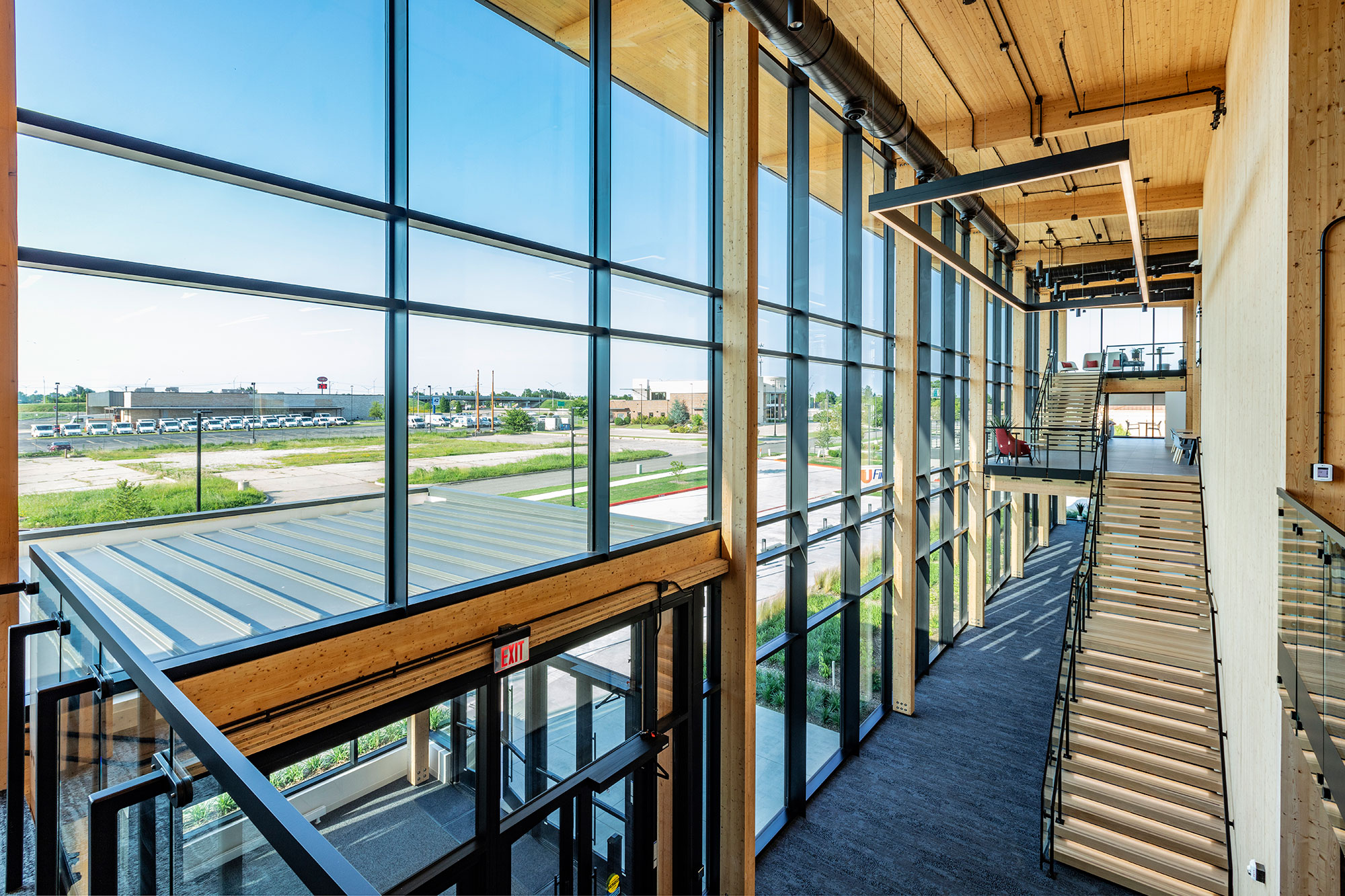
Photo courtesy of TGP
The First United Bank in Moore, Oklahoma, was designed by Gensler to support the comfort and well-being of all occupants, all while being sustainable. A three-story and 12,000-square-foot steel-framed glass curtain wall wraps around the bank’s mass timber structure. The high-performance curtain wall assembly was designed to create uninhibited sightlines to facilitate community engagement.
The glass industry plays an essential role in addressing the climate crisis. Buildings account for an estimated 40% of the problem of global carbon emissions, with building operations alone producing 27% of total emissions, according to Architecture 2030.
Glass is a critical component in addressing operational carbon emissions by reducing energy use in existing and new buildings. A recent study from Glass for Europe emphasized the difference high-performance glazing can make:
- Replacing all existing windows with “readily available high-performance glazing” by 2030 would cut annual energy use by 29% and annual carbon emissions by 28%.
- Replacing all existing windows with “improved high-performance glazing” by 2050 would cut annual energy use and carbon emissions both by 37%.
Stephen Selkowitz, principal of Stephen Selkowitz Consultants and affiliate at Lawrence Berkeley National Laboratory, estimates similarly dramatic savings for the United States if all existing commercial windows were “magically” retrofitted with next-generation glass technologies, such as highly insulating dynamic glass. “If we convert all windows, we move from a net drain of $20 billion [in energy costs] to a net gain of up to $15 billion [in energy savings],” he explains.
This multi-part article takes a deep dive into the role of glass and glazing in improving building energy and thermal performance and sustainability. It includes a broad look at considerations for carbon reduction with glass; an overview of relevant building codes, standards and regulations and how they are driving performance improvements in façade systems; details on the payback of high-performance systems and retrofits; best practices for using Environmental Product Declarations, or EPDs, for glass; opportunities and challenges of glass recycling; and an overview of existing glass product solutions for next-generation performance.
Steps to Carbon Reduction
The following is based on a panel discussion among glass industry experts, “Blueprint for Collaboration: The path towards sustainable facades,” hosted by the National Glass Association during the week of AIA A’23 in San Francisco.
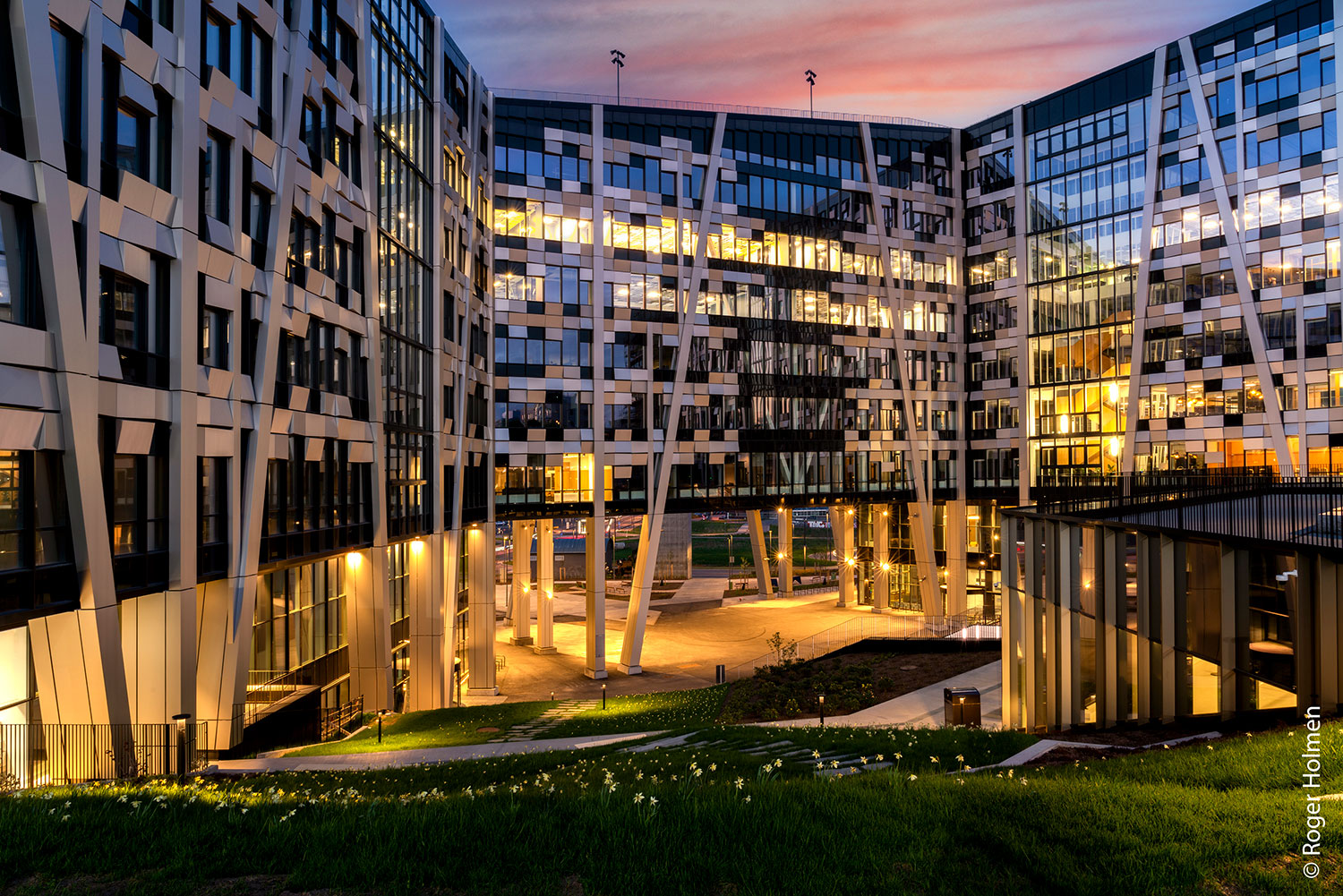
Photo courtesy of Quanex
Økern Portal in Norway features more than 32,000 square feet of triple glazing to meet thermal, safety, and sound requirements. Twelve different glass assemblies were produced with e warm-edge spacers in sizes up to 47 inches by 118 inches. The outer panes have a highly translucent, color-neutral solar control coating, while the inside has tempered or laminated glass in various thicknesses.
Improving building sustainability and reducing carbon emissions requires a move away from business as usual. For the glass industry, industry officials identify three key areas of focus.
Reduce Embodied Carbon
Embodied carbon in construction refers to greenhouse gas emissions caused during the lifecycle of a building product, including raw material extraction, transportation, manufacturing and installation. For the glass industry, the energy-intensive glass manufacturing process is the primary source of embodied carbon.
“Where does embodied carbon come from in glass manufacturing? It’s heat,” says Chris Fronsoe, national architectural team manager, Vitro Architectural Glass. “It’s where raw material goes up to about 3,000 degrees Fahrenheit and gets melted down into liquid material, and later in the float process goes back to solid.” For the manufacture of an insulating glass unit, roughly 75% of embodied carbon is generated during the manufacture of the raw glass lites in the float process due to the energy-intensive nature of the traditional float manufacturing process, says Fronsoe.
Several glass manufacturers have begun to change their processes to lower emissions in manufacturing. Increasing the use of cullet (crushed glass recycled back into the supply chain) in the process reduces the heat required to melt the materials in the furnaces, says Fronsoe. Additionally, a few glass manufacturers, such as Vitro, are using oxy-fuel technology in production, which can reduce energy consumption in glass-melting furnaces by as much as 20% and cut greenhouse gas emissions in half, he says.
Improve Operational Carbon
Operational carbon, on the other hand, refers to the emissions produced during a building’s lifespan. The glass industry has made “tremendous progress” in meeting increasingly stringent energy-efficiency requirements in the building codes, says Tom Culp, energy code consultant for the National Glass Association and owner of Birch Point Consulting. “In the 20-plus years I’ve been working in energy codes, [the industry] has cut energy use of buildings built to [the ASHRAE 90.1 Standard] by half.”
In terms of thermal performance, the industry offers dual, triple, and even quad IGUs. Fabricators have begun using two low-emissivity coatings in the IGUs for increased performance. And the industry continues to invest in next-generation thermal performance solutions, such as vacuum insulating glass and thin-triple IGUs, which provide even better efficiency within a narrow profile.
The glass industry also offers solutions to manage solar heat gain, which impacts building operational carbon. Tinted glass and switchable glass products, such as electrochromics, can further improve operational carbon.
Finally, using renewables will be essential in helping buildings become carbon-neutral, or net-zero. Rooftop solar or building-integrated photovoltaics, or BIPV, will help push operational carbon emissions even further. “Efficiency is one half of it, renewables are another,” says Culp.
Increase Recycling and Reuse
Lisa Rammig, director, Eckersley O’Callaghan, offered insights on how the industry could “reshape the future of glass” through an increase in flat glass recycling and an emphasis on rebuilding facades on existing structures. Only 6% of flat glass is recycled, according to 2017 estimates from Deloitte. If it is recycled, it is typically downcycled to glass bottles, insulation, or road filler. “Glass is a material that is fully and eternally recyclable, so why do we recycle so little flat glass? We need to change the status quo [of glass recycling],” says Rammig.
Additionally, Rammig encourages refurbishment—bringing new life into existing buildings—rather than constantly building new ones. “Don’t build. Reuse,” she says. “We should think about how we should extend the lifetimes of the buildings we have.”
Sophie Pennetier, associate director, special projects at Enclos, agrees. New buildings should also be “designed for disassembly,” she says. This means there will be easier recovery of products and materials when a building is disassembled or renovated, meaning less construction, and thus less carbon, will be produced.
Codes and Standards Drive Performance
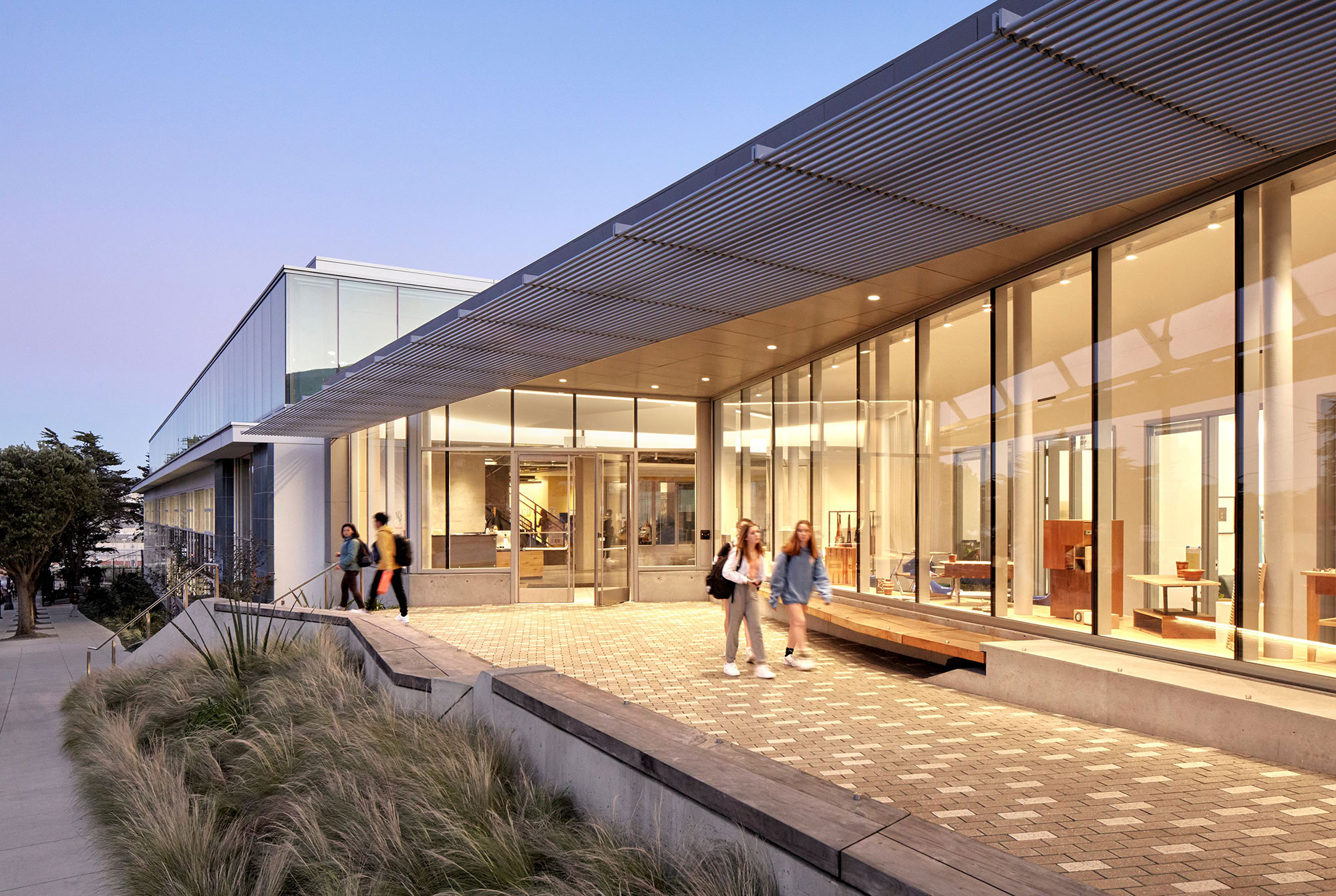
Photo courtesy of Michael David Rose Photography
Lick-Wilmerding High School in San Francisco specified Low-E glass to introduce more transparency and daylight. In 2022, the school earned an AIA COTE Top Ten Award for sustainable design excellence.
The market is seeing new codes and standards that will require the use of better glass products. New legislation is providing major incentives for numerous types of improved glass and glass-related technologies. Below are the codes, standards, laws and regulations that are pushing for better-performing glass, glazing and fenestration, particularly: Energy Star 7.0, ASHRAE 90.1, the International Energy Conservation Code and some local city and state stretch codes.
Energy Star 7.0
The recently implemented Energy Star version 7.0 greatly increases thermal performance requirements for residential windows. Meeting the more stringent performance thresholds in the Northern climate zone, which covers about 40% of the U.S., will require the most advanced double-glazed IGUs or, more likely, triple- or quad-glazed IGUs, says Selkowitz. “We will need about 10 to 20 million triple-glazing units per year.”
ASHRAE 90.1
The most recently published version of building energy standard ASHRAE 90.1 2022 includes new on-site renewable energy requirements, thermal bridging requirements and additional energy credit requirements, including credit for higher-performance fenestration, shading, daylighting, rooftop solar panels and BIPV, says Culp. The new version of the code “takes a significant step in energy efficiency, and they are on target to hit net-zero by 2031, over the next three cycles,” Culp says. “The codes are moving faster than they ever have before.”
Work is ongoing in development for the 2025 version, which includes changes to the climate zone map. According to Culp, 9% of counties move to warmer climate zones and 3% move to cooler climate zones.
For fenestration, a proposal is under review to comprehensively update the U-factor and solar heat gain coefficient requirements for curtain walls, windows, skylights, and sloped glazing. This will provide the next incremental step in performance and continue to increase the use of fourth-surface low-e coatings, warm-edge spacers, inert gas fill, advanced thermal breaks and triple glazing. Additional proposals will expand credits for products such as dynamic glazing and automated shading, and increase the requirements for on-site renewable energy systems.
IECC
The International Energy Conservation Code “is also working towards net-zero goals, and the new 2024 version takes the first step,” says Culp. Notable updates, per Culp:
- No changes in window area limits.
- Marginal improvements in commercial and residential fenestration U-factor. For example, zone 4-5 went from 0.36 to 0.34, and zone 3 went from 0.42 to 0.38. No changes in SHGC.
- Credit for high-performance windows, increased daylight area, automated shading, PV, and BIPV.
- New requirements for on-site renewable energy (PV, BIPV) with off-site options if it can’t be done on-site.

Photo courtesy of TGP
The First United Bank in Moore, Oklahoma, was designed by Gensler to support the comfort and well-being of all occupants, all while being sustainable. A three-story and 12,000-square-foot steel-framed glass curtain wall wraps around the bank’s mass timber structure. The high-performance curtain wall assembly was designed to create uninhibited sightlines to facilitate community engagement.
The glass industry plays an essential role in addressing the climate crisis. Buildings account for an estimated 40% of the problem of global carbon emissions, with building operations alone producing 27% of total emissions, according to Architecture 2030.
Glass is a critical component in addressing operational carbon emissions by reducing energy use in existing and new buildings. A recent study from Glass for Europe emphasized the difference high-performance glazing can make:
- Replacing all existing windows with “readily available high-performance glazing” by 2030 would cut annual energy use by 29% and annual carbon emissions by 28%.
- Replacing all existing windows with “improved high-performance glazing” by 2050 would cut annual energy use and carbon emissions both by 37%.
Stephen Selkowitz, principal of Stephen Selkowitz Consultants and affiliate at Lawrence Berkeley National Laboratory, estimates similarly dramatic savings for the United States if all existing commercial windows were “magically” retrofitted with next-generation glass technologies, such as highly insulating dynamic glass. “If we convert all windows, we move from a net drain of $20 billion [in energy costs] to a net gain of up to $15 billion [in energy savings],” he explains.
This multi-part article takes a deep dive into the role of glass and glazing in improving building energy and thermal performance and sustainability. It includes a broad look at considerations for carbon reduction with glass; an overview of relevant building codes, standards and regulations and how they are driving performance improvements in façade systems; details on the payback of high-performance systems and retrofits; best practices for using Environmental Product Declarations, or EPDs, for glass; opportunities and challenges of glass recycling; and an overview of existing glass product solutions for next-generation performance.
Steps to Carbon Reduction
The following is based on a panel discussion among glass industry experts, “Blueprint for Collaboration: The path towards sustainable facades,” hosted by the National Glass Association during the week of AIA A’23 in San Francisco.

Photo courtesy of Quanex
Økern Portal in Norway features more than 32,000 square feet of triple glazing to meet thermal, safety, and sound requirements. Twelve different glass assemblies were produced with e warm-edge spacers in sizes up to 47 inches by 118 inches. The outer panes have a highly translucent, color-neutral solar control coating, while the inside has tempered or laminated glass in various thicknesses.
Improving building sustainability and reducing carbon emissions requires a move away from business as usual. For the glass industry, industry officials identify three key areas of focus.
Reduce Embodied Carbon
Embodied carbon in construction refers to greenhouse gas emissions caused during the lifecycle of a building product, including raw material extraction, transportation, manufacturing and installation. For the glass industry, the energy-intensive glass manufacturing process is the primary source of embodied carbon.
“Where does embodied carbon come from in glass manufacturing? It’s heat,” says Chris Fronsoe, national architectural team manager, Vitro Architectural Glass. “It’s where raw material goes up to about 3,000 degrees Fahrenheit and gets melted down into liquid material, and later in the float process goes back to solid.” For the manufacture of an insulating glass unit, roughly 75% of embodied carbon is generated during the manufacture of the raw glass lites in the float process due to the energy-intensive nature of the traditional float manufacturing process, says Fronsoe.
Several glass manufacturers have begun to change their processes to lower emissions in manufacturing. Increasing the use of cullet (crushed glass recycled back into the supply chain) in the process reduces the heat required to melt the materials in the furnaces, says Fronsoe. Additionally, a few glass manufacturers, such as Vitro, are using oxy-fuel technology in production, which can reduce energy consumption in glass-melting furnaces by as much as 20% and cut greenhouse gas emissions in half, he says.
Improve Operational Carbon
Operational carbon, on the other hand, refers to the emissions produced during a building’s lifespan. The glass industry has made “tremendous progress” in meeting increasingly stringent energy-efficiency requirements in the building codes, says Tom Culp, energy code consultant for the National Glass Association and owner of Birch Point Consulting. “In the 20-plus years I’ve been working in energy codes, [the industry] has cut energy use of buildings built to [the ASHRAE 90.1 Standard] by half.”
In terms of thermal performance, the industry offers dual, triple, and even quad IGUs. Fabricators have begun using two low-emissivity coatings in the IGUs for increased performance. And the industry continues to invest in next-generation thermal performance solutions, such as vacuum insulating glass and thin-triple IGUs, which provide even better efficiency within a narrow profile.
The glass industry also offers solutions to manage solar heat gain, which impacts building operational carbon. Tinted glass and switchable glass products, such as electrochromics, can further improve operational carbon.
Finally, using renewables will be essential in helping buildings become carbon-neutral, or net-zero. Rooftop solar or building-integrated photovoltaics, or BIPV, will help push operational carbon emissions even further. “Efficiency is one half of it, renewables are another,” says Culp.
Increase Recycling and Reuse
Lisa Rammig, director, Eckersley O’Callaghan, offered insights on how the industry could “reshape the future of glass” through an increase in flat glass recycling and an emphasis on rebuilding facades on existing structures. Only 6% of flat glass is recycled, according to 2017 estimates from Deloitte. If it is recycled, it is typically downcycled to glass bottles, insulation, or road filler. “Glass is a material that is fully and eternally recyclable, so why do we recycle so little flat glass? We need to change the status quo [of glass recycling],” says Rammig.
Additionally, Rammig encourages refurbishment—bringing new life into existing buildings—rather than constantly building new ones. “Don’t build. Reuse,” she says. “We should think about how we should extend the lifetimes of the buildings we have.”
Sophie Pennetier, associate director, special projects at Enclos, agrees. New buildings should also be “designed for disassembly,” she says. This means there will be easier recovery of products and materials when a building is disassembled or renovated, meaning less construction, and thus less carbon, will be produced.
Codes and Standards Drive Performance

Photo courtesy of Michael David Rose Photography
Lick-Wilmerding High School in San Francisco specified Low-E glass to introduce more transparency and daylight. In 2022, the school earned an AIA COTE Top Ten Award for sustainable design excellence.
The market is seeing new codes and standards that will require the use of better glass products. New legislation is providing major incentives for numerous types of improved glass and glass-related technologies. Below are the codes, standards, laws and regulations that are pushing for better-performing glass, glazing and fenestration, particularly: Energy Star 7.0, ASHRAE 90.1, the International Energy Conservation Code and some local city and state stretch codes.
Energy Star 7.0
The recently implemented Energy Star version 7.0 greatly increases thermal performance requirements for residential windows. Meeting the more stringent performance thresholds in the Northern climate zone, which covers about 40% of the U.S., will require the most advanced double-glazed IGUs or, more likely, triple- or quad-glazed IGUs, says Selkowitz. “We will need about 10 to 20 million triple-glazing units per year.”
ASHRAE 90.1
The most recently published version of building energy standard ASHRAE 90.1 2022 includes new on-site renewable energy requirements, thermal bridging requirements and additional energy credit requirements, including credit for higher-performance fenestration, shading, daylighting, rooftop solar panels and BIPV, says Culp. The new version of the code “takes a significant step in energy efficiency, and they are on target to hit net-zero by 2031, over the next three cycles,” Culp says. “The codes are moving faster than they ever have before.”
Work is ongoing in development for the 2025 version, which includes changes to the climate zone map. According to Culp, 9% of counties move to warmer climate zones and 3% move to cooler climate zones.
For fenestration, a proposal is under review to comprehensively update the U-factor and solar heat gain coefficient requirements for curtain walls, windows, skylights, and sloped glazing. This will provide the next incremental step in performance and continue to increase the use of fourth-surface low-e coatings, warm-edge spacers, inert gas fill, advanced thermal breaks and triple glazing. Additional proposals will expand credits for products such as dynamic glazing and automated shading, and increase the requirements for on-site renewable energy systems.
IECC
The International Energy Conservation Code “is also working towards net-zero goals, and the new 2024 version takes the first step,” says Culp. Notable updates, per Culp:
- No changes in window area limits.
- Marginal improvements in commercial and residential fenestration U-factor. For example, zone 4-5 went from 0.36 to 0.34, and zone 3 went from 0.42 to 0.38. No changes in SHGC.
- Credit for high-performance windows, increased daylight area, automated shading, PV, and BIPV.
- New requirements for on-site renewable energy (PV, BIPV) with off-site options if it can’t be done on-site.
State Stretch Codes
States such as New York and Massachusetts, have adopted or are nearing adoption of new stretch energy codes that set more stringent thermal performance requirements than the national energy codes, says Culp. While the stretch codes initially start as voluntary standards, they become mandatory when adopted by the local jurisdiction, including significant cities such as New York City and Boston. The stretch codes “are very aggressive,” says Culp. Where adopted, the codes will require that new buildings include the highest-performing glass units, including the use of new products such as vacuum glazing as well as triple-pane assemblies.
Inflation Reduction Act
The Inflation Reduction Act of 2022 included numerous provisions that will drive performance improvements in buildings. According to Culp, the IRA includes $1 billion in state and local government grants intended to accelerate the adoption of the latest energy codes and a zero-energy code. The IRA also expands tax deductions for energy-efficiency improvements in commercial buildings and includes tax incentives for high-performance building products. Two notable inclusions include sizable tax credits for electrochromic glass and for PV and BIPV.
Payback of High-Performance Windows and Retrofits
The following is based on the NGA document, High-Performance Windows Can Help Save the World.
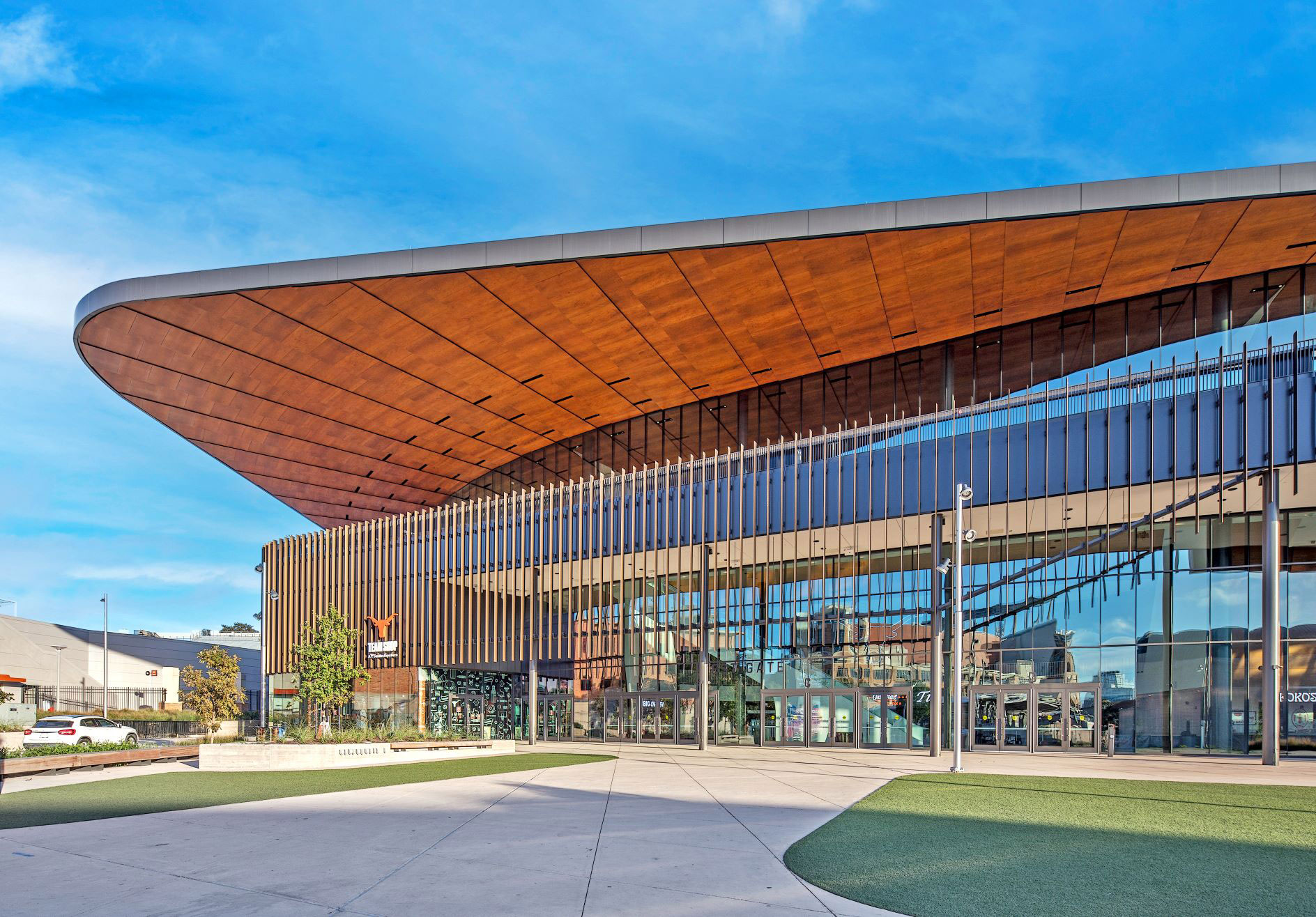
Photo courtesy of Tom Kessler
The Moody Center on the University of Texas at Austin campus boasts a sweeping 360-degree curtainwall design featuring Low-E glass.
Higher-performing facades mean higher-performing buildings, resulting in improvements in operational carbon. Some considerations about retrofits, the payback of high-performance systems, and building resiliency:
Window Retrofit is Key to Decarbonization
Residential and commercial buildings are responsible for almost 40% of North America’s carbon dioxide emissions and energy usage. For example, existing buildings with inefficient windows account for about 70% of New York City emissions. Additionally, 80% of buildings that will exist in 2050 already exist today, meaning retrofits will be critical to improving operational carbon on a large scale in decades to come.
High-performance windows are up to 80% more efficient than standard windows. New residential windows that qualify for the Energy Star Most Efficient designation are up to 40% more efficient than new standard windows. Upgrades in window technology in the last 20 years have significantly improved heat-loss performance for residential and commercial structures.
New windows can pay back embodied carbon in less than a year. Glass is typically 2% to 5% of a building project’s embodied carbon. Upgrading to a more efficient glazing system will initially add some additional embodied carbon. However, in both commercial and residential installations, operational energy/carbon savings from the more efficient windows will offset that initial increase in six to 20 months in a cold climate, and thereafter, provide additional annual carbon savings.
Decarbonization efforts should include both embodied and operational carbon. Existing legislation targeting embodied carbon does consider the long-term benefits that glazing materials provide by mitigating annual carbon impacts through ongoing operational cost savings. Upgrading installed windows improves total building energy performance by up to 20%, improves comfort and health for occupants, and reduces operational costs and carbon emissions.
High-performance glass is used in on-site renewable energy products. High-performance glass is a key component in the domestic supply of solar panels and BIPV. Increased use of on-site renewable energy is critical to achieving net-zero energy and carbon targets, and will also help improve grid resiliency and U.S. energy independence.
High-performance windows improve building resiliency. In the event of extended power disruption, high-performance windows enhance building resiliency and maintain habitable interior temperatures for longer periods of time. Improvements allow for the downsizing of replacement mechanical systems and more effective use of funding while increasing building resiliency in extreme weather and blackouts.
Retrofitting buildings with high-performance windows creates job opportunities for a skilled workforce. The installation of high-performance window products supports the creation of skilled workers’ jobs along with urban renewal. At the local level, changes in building performance standards requiring improvements in existing buildings are taking off, but adoption among cities is scattered. Federal-level initiatives encouraging window and building envelope upgrades, as well as lighting and mechanical system updates, would create additional manufacturing demand and related jobs.
Glass EPDs and Caution Over Comparison
The following is based on the NGA Glass Technical Paper, General EPD Education.
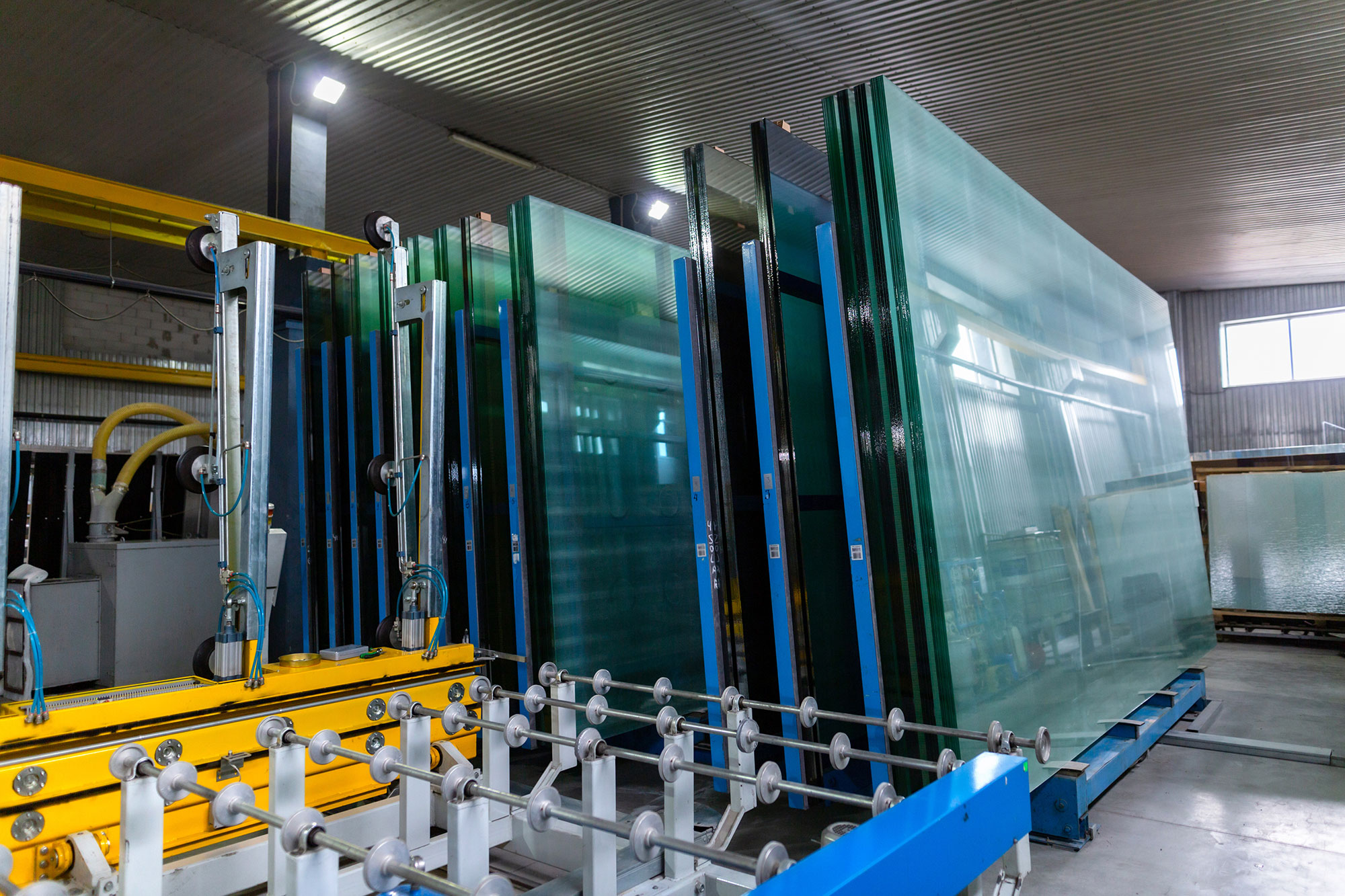
Photo courtesy of NGA
Glass is typically 2% to 5% of a building project’s embodied carbon. Upgrading to a more efficient glazing system will initially add some additional embodied carbon.
Environmental Product Declarations enable the assessment of the environmental impact of products and label them accordingly. They contain extensive and independently verified environmental data about a product, from raw material procurement to disposal. EPDs allow consumers or design professionals in the building and construction industry to make better-informed decisions about the environmental impacts of the building material products chosen for projects.
However, it has been observed in the marketplace that architectural, engineering and construction professionals are trying to compare EPD values, which is not encouraged, nor always appropriate, and could lead to misleading conclusions.
Flat Glass EPD
It is important to understand how to properly read, interpret, and utilize the data published in the industry-average Flat Glass EPD, developed by the NGA. This is especially critical when attempting to compare this data to manufacturer-specific flat glass EPDs, as well as the EPDs of other materials and systems.
NGA and its member companies created the industry-average Flat Glass EPD to better understand their glass products’ environmental performance from cradle-to-gate. The NGA EPD conforms to the NGA Product Category Rule, or PCR, for Flat Glass, which was published by NSF in September 2020 and describes the format and requirements for conducting lifecycle assessments and creating EPDs for flat glass products. The Flat Glass PCR requires that EPDs include the following disclaimer advising against comparisons:
“This EPD was not written to support comparative assertions. Even for similar products, differences in declared unit, use and end-of-life stage assumptions, and data quality may produce incomparable results. It is not recommended to compare EPDs with another organization, as there may be differences in methodology, assumptions, allocation methods, data quality such as variability in data sets, and results of variability in assessment software tools used.”
Caution Against Comparison
In general, EPDs may be used to inform and comply with the requirements of green building rating systems and legislative actions. The purpose of an EPD is to provide information on several environmental impacts of a product over the lifecycle, either cradle-to-gate or cradle-to-grave.
EPDs typically rely on estimations of impacts, therefore the accuracy will differ for any particular product line and reported impact. EPDs are not meant to be comparative assertions and may not be comparable or have limited comparability. According to clause 5.5 of ISO 21930:2017: “Comparison of construction products using an EPD shall be carried out in the context of the construction works. Consequently, comparison of the environmental performance of construction products using the EPD shall consider all the relevant information modules over the full lifecycle of the products within the construction works.”
This is reinforced in “Critical Issues When Comparing Whole Building & Building Product Environmental Performance” from the MIT Concrete Sustainability Hub: “Only compare building products in the context of a whole building. With regards to building products, unless the thermal properties, such as thermal conductance and thermal diffusivity, and envelope permeability are exactly the same, use of the products under comparison would cause different operational energy consumption.”
LEED V4.1
In acknowledgment of the challenges associated with comparing EPDs, LEED v4.1, option 2, attempts to address this by limiting comparisons to be made using an individual product EPD and demonstrating measurable improvements in different versions of that EPD. This is in contrast to LEED v4.0, which compared an EPD to an industry-average EPD. LEED v4.1 states: “To encourage the use of products and materials for which lifecycle information is available and that have environmentally, economically, and socially preferable lifecycle impacts. To reward project teams for selecting products from manufacturers who have verified improved environmental lifecycle impacts.”
Critical Characteristics
EPDs are developed, particularly those per ISO 14025, with critical characteristics unique to that published document. Extreme caution should be used when comparing EPDs and the resulting global warming potentials. Significant differences may exist in some attributes, even for similar products. Comparing EPD values with differences in the characteristics below can yield large errors between the values and should be considered. When comparing EPDs, at a minimum, ensure the following are identical:
- The same Product Category Rule is used
- Declared unit (comparison of EPD results on a mass basis is insufficient; the technical performance of the product should be considered)
- System boundary (use and end-of-life stage assumptions)
- Data quality, such as variability in data sets and broad error margins in data
- EPD methodology and assumptions
- Allocation methods
- Variability in assessment software tools used
- Program manager (program operator)
- Data sources (GABI version, for example) on which assumptions are based
- Manufacturer-specific versus industry-wide
- Facility-specific versus multiple facilities
- Suppliers/supply chain
- Age of the EPD
Glass Recycling Opportunities and Challenges

Photo courtesy of NGA
From recycling back into the melt furnace, recycled glass materials can be used in various industries to make new windows, glass containers, road grade, fiberglass, reflective highway paint, landscaping products, countertops, and coastal restoration materials.
Higher recycled material content is a key element for future decarbonization efforts for the glass industry. Glass can be infinitely recycled in flat glass and bottling operations, so continued reuse further supports the glass industry, supports a circular economy, and reduces waste and landfills. These benefits drive material choice decisions, such as using glass containers instead of less recyclable materials such as single-use plastics.
Glass recycled materials can be used in various industries, from recycling back into the melt furnace to make new windows, glass containers, road grade, fiberglass, reflective highway paint, landscaping products, countertops and coastal restoration materials.
Recycled glass is valuable. Recycled glass, or cullet, helps reduce the energy and emission burdens on glass manufacturing by:
- Reducing the need for raw material mining.
- Reducing trucking and related emissions, as making 1,000 tons of glass requires 1,000 tons of cullet or about 1,200 tons of raw material, or “batch.”
- Reducing furnace emissions. Batch material and firing fuels are both off-gas during the glass-making process. Increased cullet usage significantly reduces the emissions from production.
- Reducing gas usage. Cullet is easier to melt than batch, so lower furnace fuel is required.
- Reducing the global warming potential of glass, as less energy is needed to make glass when cullet is available.
Recycling glass supports domestic supply and workforce.
- Cullet should be considered a viable, reusable and sustainable domestic material supply chain.
- The glass recycling industry creates jobs and tax benefits.
Glass recycling is challenging.
- Economics and glass quality requirements present challenges for glass recycling.
- Freight costs typically drive recycling decisions. Long hauls of heavy products often make recycling a cost challenge.
- Sorting and cleaning of cullet for certain applications can be expensive. In contrast, landfill costs are generally inexpensive in the United States.
- Contamination from even trace amounts of certain elements like nickel and aluminum can dramatically impact glass quality.
Solutions in Glass
This section presents a range of next-level performance technologies available from the glass industry, including improved IGUs, VIG, and thin-glass solutions. Additionally, it looks at dynamic glass, which provides solutions for solar control, and at BIPV, which can provide on-site energy generation.
Advanced IGUs

Photo courtesy of NGA
Advanced IGUs offer additional performance improvements through a variety of methods, including filling the air space with gas, using warm-edge or other higher thermal performance spacers, or adding additional lites.
Basics: Widely used in commercial and residential construction since the 1960s, IGUs consist of two or more lites of glass separated by a hermetically sealed air space to provide more thermal, sound, and solar insulation than possible with single-glazed fenestration. Advanced IGUs offer additional performance improvements through a variety of methods, including filling the air space with gas (argon, or, for even better performance, krypton), using warm-edge or other higher thermal performance spacers, or adding additional lites (and thus additional cavities) to the unit. For better solar control, low-e coatings can be added to the No. 2 surface, and now, thanks to advancements in coatings, the No. 4 surface, of a traditional double-glazed unit.
Performance: Highly insulating glazing solutions—doubles with improved spacers and two low-e coatings, or multi-cavity units—will likely be required to meet the more stringent energy codes and standards mentioned in the previous section, says Culp. The U-factor requirements in the New York and Massachusetts stretch codes, for example, will push for “triple glazing or fourth-surface low-e, with gas fill and better frames,” he says.
The updated Energy Star requirements will also pose challenges. In the previous version, about 80% of the residential window market met the 0.27 center of glass U-factor requirement for the Northern climate. Energy Star 7.0 moves that number to a U-factor of 0.22. Only the very best-performing double-glazed units currently on the market would be able to meet the new requirements, Selkowitz says. “For the first time in 20 or 25 years, we’re having to take a hard look at that standard double-glazed, argon-filled, low-e unit.”
History: The double-glazed IGU was patented in the U.S. in 1865 by Thomas Stetson and was commercialized in the 1930s. According to estimates from Ducker Worldwide, IGUs accounted for about 12% of the U.S. market share of new residential glazing in 1970, and quickly grew to about 70% by 1980. By 1990, nearly all new windows sold into the residential market were insulating.
The popularity of improved IGUs with low-e coatings accelerated quickly in recent decades, and the product now accounts for about 80% of the market, according to Ducker. However, multi-cavity IGUs represent only a slim market share for residential glazing at about 3%.
IGUs with emerging technologies—such as VIG, suspended film or Aerogel—remain more niche performance solutions.
Development: The global IG window market is projected to reach U.S. $17.2 billion by 2026, growing at a compound annual growth rate of 6.1% from 2021 to 2026, according to ResearchAndMarkets.com. The growing trend of green rating systems in various countries is likely to contribute to the growth of the IG window market, with North America projected to be the largest regional market.
The insulating market has also become more complex with the addition of several emerging IG technologies that offer a step change in thermal performance. Such technologies include VIG and thin-glass multi-cavity IGUs, which are both explored in-depth later in this article. Other technologies include IGUs with a suspended film, which has been available on the market for several decades, or units with Aerogel in the cavity, which is currently available but only in a translucent state.
Challenges: The North American IG market has faced challenges moving beyond traditional double-glazed units. Traditional multi-cavity IGUs, while popular in Europe, have gained only minimal traction in the U.S. “There are obstacles to triple pane. Many manufacturers say it is too heavy, too wide, too expensive. It has long ROIs,” says Selkowitz.
The industry is also facing new challenges with krypton gas-filled insulating units. Krypton has gained popularity in recent years as a higher-performing gas option for IGUs. However, the cost of krypton has increased due to higher demand for krypton in the communication sector and due to new difficulties in accessing krypton, which is sourced in large part from Ukraine and Eastern Europe, says Selkowitz.
Resources: The NGA published the Performance Improvements in IGUs glass technical paper in 2016 and updated it in 2022. Resources: The NGA published the Performance Improvements in IGUs glass technical paper in 2016 and updated it in 2022. Download the resource.
Additionally, watch a webinar from Selkowitz discussing the latest IGU technologies—and the research and development still in progress—that will aid in the reduction of a building’s carbon footprint and bring us closer to the goal of a net-zero energy building.
BIPV
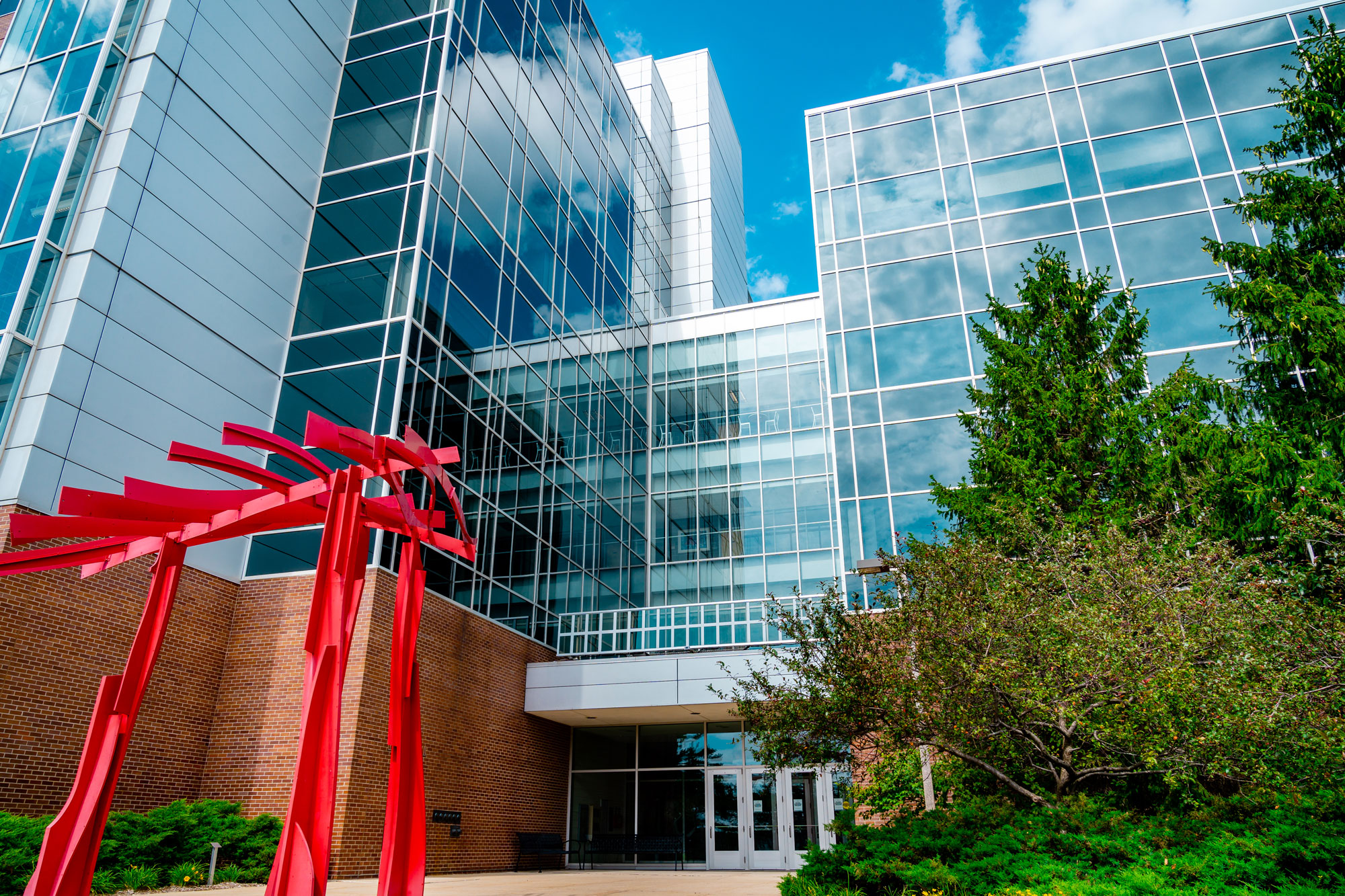
Photo courtesy of Ubiquitous Energy
Ubiquitous Energy transparent solar window project at Michigan State University in East Lansing, Michigan.
Basics: Building-integrated photovoltaics are solar energy-generating systems incorporated into a building envelope. They can be used in windows, facades, canopies, skylights, and more, providing opportunities for energy generation on all surfaces of a building. Glass is an essential component in most BIPV products, protecting solar cells and modules while maximizing solar and light transmission.
Performance: BIPV meets the requirements for sustainability and integration of alternative sources of energy. Growing the use of on-site renewable energy is critical to achieving net-zero energy and carbon targets and will also help increase grid resiliency and U.S. energy independence. Additionally, new versions of the energy codes, including ASHRAE 90.1 2022 and the 2024 IECC, include requirements for on-site renewables, which would include BIPVs.
History: Photovoltaic technology was invented in 1954 when Daryl Chapin, Calvin Fuller, and Gerald Pearson developed the silicon PV cell at Bell Telephone Laboratories, according to the U.S. Department of Energy’s Energy Efficiency and Renewable Energy office. BIPVs came to fruition in the 1990s. The evolution of the technology in recent years has helped it to become more mainstream, says Jemssy Alvarez, product manager, Vitro Architectural Glass.
Development:Alvarez says he expects to see BIPV in more places in and around buildings as owners and architects look to more sustainable energy sources. “I think you’re going to start seeing park benches that are going to have solar panels installed so people utilizing those facilities will have the ability to charge their phones, and more atriums and canopies and skylight applications with PV integrated because it’s a natural fit,” he says.
Additionally, industry manufacturers have developed BIPV products that offer a range of aesthetic options for designers, including transparent or near-transparent BIPVs that offer the benefits of traditional glass systems while generating energy.
“Transparent solar window products are aesthetically pleasing and energy -efficient. They look and function like traditional windows but also double as renewable energy generation sources that help provide clean electricity to the home or building,” says Veeral Hardev, vice president of strategy, Ubiquitous Energy.
Ubiquitous Energy is in the early commercialization phase with transparent solar window products, says Hardev. “We are currently building our first high-volume transparent solar window manufacturing facility here in the U.S. We expect that this facility will start producing window units as large as 5 feet by 10 feet in 2025,” he says. “These window units will be sold into the residential and commercial markets directly through our partners, including [Andersen Windows & Doors], as well as commercial building developers and contractors.”
Challenges: A challenge of BIPV is cost. Alvarez says it’s hard for BIPV to compete with the pricing of what someone will pay in electricity. “However, in time, the cost of energy isn’t going to get any cheaper, and at some point, there’s going to be a parity between what you can do with these renewable sources and what it will cost you from the standard,” he says.
Resources: The NGA developed the Glass Properties Pertaining to Photovoltaic Applications as a primer on the role of glass in PV, including the types of glass used and the roles of glass as both a cover or backing for PV. The document was originally developed in 2014 (updated in 2019). Download the complete glass technical paper.
VIG
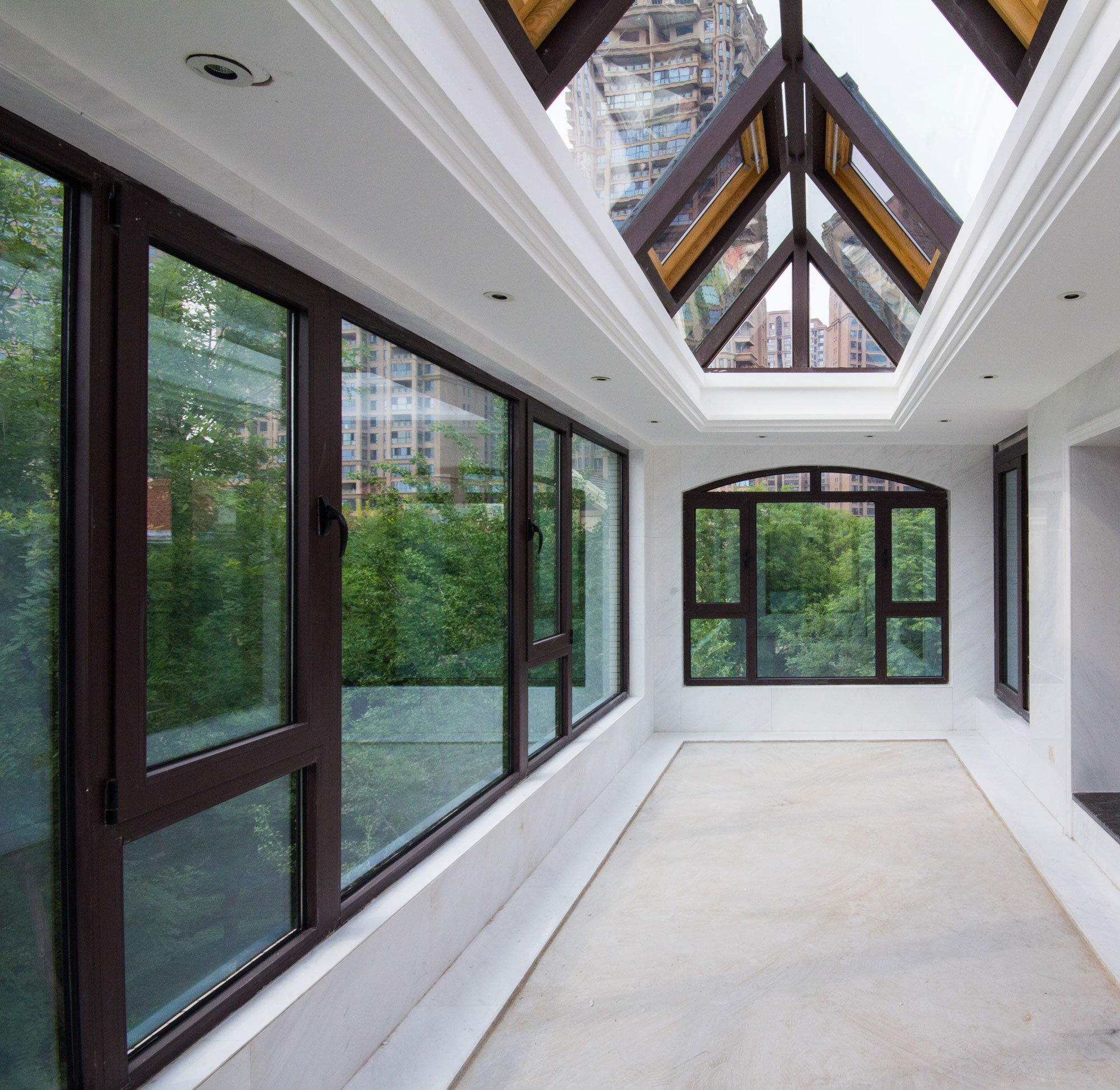
Photo courtesy of VIG Glass Technologies
A residential project in Shaanxi, China, with VIG in windows and skylights. The glass is laminated to provide additional protection.
Basics: In VIG, two glass panes are hermetically sealed together around the edges, separated by micro spacers, and the air between the glass panes is extracted. The vacuum is very effective at minimizing conduction and convection heat losses, lowering the U-factor at a very thin cavity depth.
Performance: The overall insulating performance of VIG rivals that of traditional windows with an R-value of 10, approaching a properly insulated wall rated at 12 or higher, says Daniel Sutton, product manager, Versatex Building Products, and former product manager for Vitro.
“Historically speaking, the insulating value of windows has been dramatically less performing than a wall with insulation,” he says. “With VIG, now you’re leveling the playing field in terms of the insulating performance that is roughly on par with wall insulation.”
History: The concept of VIG was first described in a 1913 German patent by Zoller. The first commercial VIG product, Spacia, was launched by Nippon Sheet Glass in 1996.
Development: “Where VIG is going, it’s now getting into bigger sizes with architects and designers. The bigger the size, the bigger the windows, the better we can get more natural light in,” Sutton explains. Additionally, manufacturers will begin moving toward temperature/heat-strengthened glass because of its versatility, Sutton says.
Challenges: VIG comes with some fabrication challenges. According to NGA’s technical paper on VIG, the units are limited in size. Units must have at least two 90-degree corners, and shapes are limited to fairly simple parallelograms or simple arcs. VIG is also not available as bent glass.
Sutton says another limitation of VIG is its dependence on what low-e coating is used within the vacuum space; hopefully, as the technology evolves there will be more freedom to use different high-performing low-e coatings to meet different energy restrictions or energy code mandates.
A limitation of VIG is that there is limited North American-based domestic sourcing for VIG, so access and cost can be a challenge. Sutton says Vitro hopes to mitigate this in the future and begin VIG manufacturing in the U.S.
Resources: The NGA developed the Vacuum Insulating Glazing glass technical paper to offer guidance on VIG market applications, performance, and size applications. Energy performance, acoustic improvements, size and shape options, as well as testing standards, and a thorough list of terminology specific to VIG are also outlined in the technical paper. Download the document.
Thin Glass
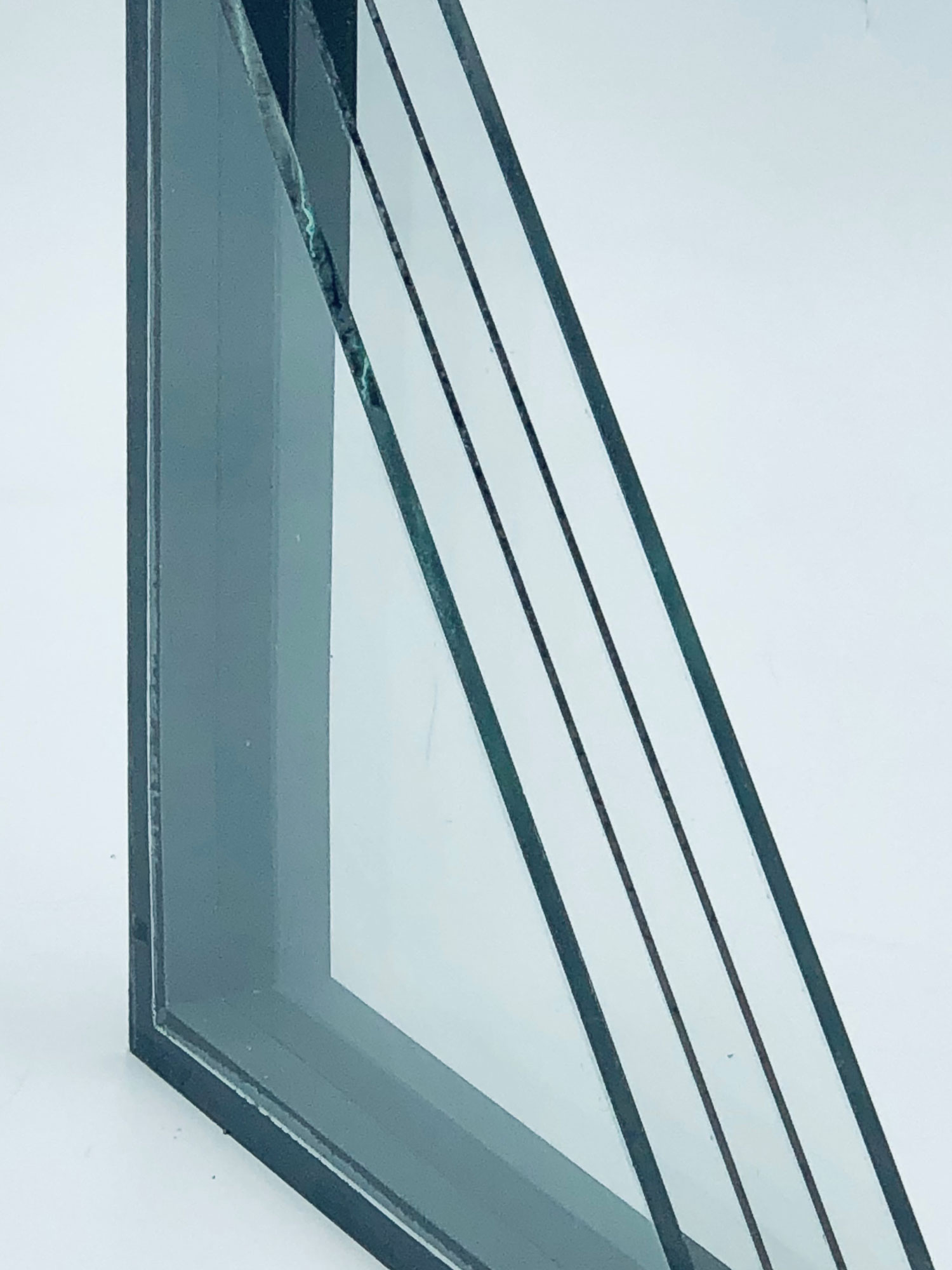
Photo courtesy of NGA
Thin glass, when used in a multi-cavity IGU, allows for large thermal performance improvements without adding much weight.
Basics: The glass industry is looking to thin glass—generally considered any glass less than 1.6 millimeters thick—in two key applications to greatly improve window system thermal performance. First is the use of thin glass as interior lite or lites in multi-cavity IGUs. The second, more recent, application is thin glass in window retrofit systems.
Thin glass is produced using two methods: horizontal float soda line (a process used by NSG Group) and vertical fusion drawn boro-aluminosilicate (a process used by Corning).
Performance: Thin glass, when used in a multi-cavity IGU, allows for large thermal performance improvements without adding much weight. Additionally, thin-glass IGUs are much thinner than traditional multi-cavity IGUs and can more easily be accommodated by existing framing systems.
“With the thin triple, you get about an R-8 center of glass,” says Selkowitz. “And if you have a slightly larger and wider glass package, you can add two pieces of thin triple glass (making a quad IGU) and get R-14 center of glass. … This is great news as it offers new opportunities for glass to provide improved thermal comfort, reduced HVAC size, and deeper energy savings.”
Development: Thin-glass triple glazing was invented by Selkowitz in the late 1980s, achieving an invention registration in 1991. However, “no one wanted triples back then and thin glass didn’t exist,” Selkowitz says. Then came the fast emergence and growth of smartphones and flat-screen televisions in the 2000s, which created a new market for thin glass. Today, thin glass is readily available and affordable. “There is a whole industry out there that knows how to make, cut, and transport thin glass. It’s a pretty fast learning curve to bring this to industry,” Selkowitz says.
Thin-glass multi-cavity IGUs have been produced in North America for several years by Alpen High Performance Products, says company president Brad Begin. The company began working with the U.S. DOE on developing thin-glass triples for commercial use in 2018. By 2019, it had launched as a product offering, following extensive testing and field validation. By mid-2023, the company expects to pass a million square feet of thin-glass products sold into the market for both commercial and residential applications. “Thin triples are at niche volume now, but [the technology] has the potential to be more mainstream,” says Selkowitz. “From the technology side, there is nothing to hold it back. The price is fine. The handling is fine. What’s needed is the market pull side.”
Thin-glass retrofit products are newer but are already at the installation stage. Alpen received a patent for its thin-glass high-performance secondary window in 2021. Begin says that retrofit products help to address the “real elephant in the room, which is trying to address how we make existing buildings better. … On the commercial side, even though half of the U.S. building stock [has] single or low-performing double [windows], only a very small percentage of existing stock does anything with replacement or upgrade.”
Challenges: “The one thing you can’t do with thin glass is temper it,” says Selkowitz. However, there is ongoing research in the industry to address tempering issues, and Begin notes the industry has “six different market-ready solutions that solve the issue.”
The thin-glass industry has also been limited by size. However, Begin says Alpen sources thin-glass sheets that are typically 50 to 60 square feet, with access to sizes of 70 square feet or larger.
Resources: The January NGA Glass Conference: Miramar Beach included two presentations on thin triples:
- Thin Triple Glazings: Potentials, Status, Futures Concept Products, by Selkowitz
- Thin Glass from a Fabricator Front Line Perspective, by Begin
The presentations are available as webinars from the NGA.
Dynamic Glass
Basics: Dynamic glass, sometimes referred to as smart glass, switches between clear and tinted states on demand, providing glare control, addressing solar heat gain considerations by reducing a building’s energy load for heating and cooling, and offering access to natural daylight and unobstructed views. Dynamic glass technologies make it possible to change the light transmission characteristics of the glass at required times. These features make it an efficient and environmentally friendly tool for filtering heat and light for more efficient climate control in enclosed spaces. While the glass industry produces smart glass products intended to provide privacy solutions, this section focuses on switchable products designed for solar control.
Performance: There are currently three primary technologies for dynamic glass that are used in the built environment: electrochromic, photochromic and thermochromic. The principle common to them all is the use of materials whose exposure to electrical voltage, heat or sunlight changes their composition and consequently their color and texture.
Electrochromic glass technology uses a small DC voltage to change a thin coating from clear to tinted and darken the interior of a piece of glass, all within only a few minutes. This color-changing technology can block 99% of sunlight and is considered one of the most energy-efficient solutions, contributing greatly to LEED scores in architecture. Photochromic glass materials change their color composition when exposed to ultraviolet wave radiation, usually from sunlight, and darken while absorbing the light and heat of the sun. And thermochromic glass materials change color and darken when exposed to higher temperatures.
The electrochromic technology segment dominated the global smart glass market, according to Grand View Research, with a share of 83.6% in 2021 due to low driving voltage, high blockage ratio of ultraviolet rays and capability to integrate with large glass panels.
History: Dynamic glass products have been around for over 100 years and have only recently been implemented, and some are based on modern discoveries. The science behind the electrochromic process goes back to patents in 1843 from Scottish engineer Alexander Bain, while thermochromic glass was under development in laboratories as early as the 1960s, and the first photochromic technology was offered in 1966 by Corning Glass Works Inc.
Development: Over the past few decades, advancements in smart window research have moved the technology well beyond the lab. The market for smart glass is expected to reach $7.5 billion by 2028, according to Grand View Research. Additionally, according to Culp, the adoption of smart windows is expected to grow quickly with the Inflation Reduction Act adding dynamic glass to the Investment Tax Credit, covering up to 30% of the costs associated with dynamic glass for eligible projects and moving it towards cost parity with traditional glazing and shading solutions.
Next-generation thermochromic windows may use different materials that absorb light instead of reflecting it, creating a continuous tint as temperatures rise, similar to electrochromic windows. One thermochromic material that’s long been studied is vanadium dioxide, or VO2, which can transition at higher temperatures (about 154°F), increasing its ability to reflect infrared light. This allows visible light to continue to stream in, brightening the room, while lowering the amount of incoming heat, keeping the room cooler.
Challenges: Electrochromic glass, the most common technology for switchable glass, does have limitations when it comes to switching speed and shows characteristics of blue glass appearance in the tinted state. There are also challenges for widespread use, such as expense and an installation process that requires some additional training.
Resources: The NGA published the glass technical paper Dynamic Glazing for High Performance Buildings, which discusses the characteristics of dynamic glazing that can mitigate against the influence of the sun. The paper was updated in 2018. Download the document.
Katy Devlin is the content director for the National Glass Association and the editor in chief for the NGA’s leading architectural glass publication, Glass Magazine. Norah Dick is Glass Magazine’s senior editor; Tara Lukasik, managing editor; and Rachel Vitello, assistant editor.





















